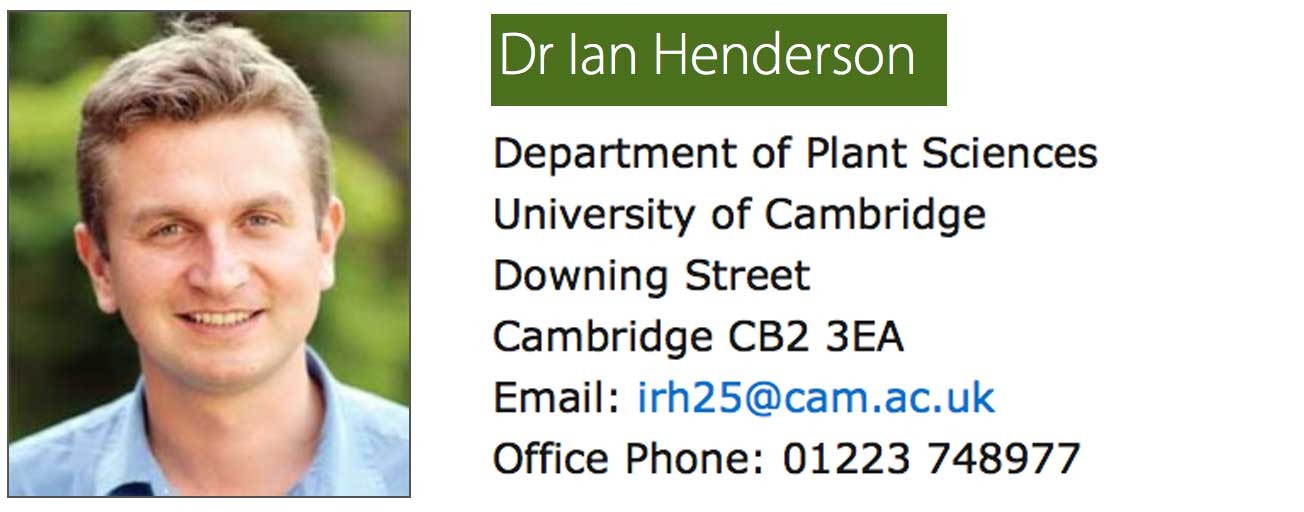博文
Genome Research:NA甲基化影响拟南芥基因组减数分裂DSB分布
||
 �
�
Nucleosomes and DNA methylation shape meiotic DSB frequency in Arabidopsis thaliana transposons and gene regulatory regions
First author: Kyuha Choi; Affiliations: University of Cambridge (剑桥大学): Cambridge, England
Corresponding author: Ian R. Henderson
Meiotic recombination (减数分裂重组) initiates from DNA double-strand breaks (DSBs) generated by SPO11 topoisomerase-like complexes (拓扑异构酶复合物). Meiotic DSB frequency varies extensively along eukaryotic chromosomes, with hotspots (热点) controlled by chromatin and DNA sequence. To map meiotic DSBs throughout a plant genome, we purified and sequenced Arabidopsis thaliana SPO11-1-oligonucleotides. SPO11-1-oligos are elevated in gene promoters, terminators, and introns, which is driven by AT-sequence richness that excludes nucleosomes (核小体) and allows SPO11-1 access. A positive relationship was observed between SPO11-1-oligos and crossovers genome-wide, although fine-scale correlations were weaker. This may reflect the influence of interhomolog polymorphism on crossover formation, downstream from DSB formation. Although H3K4me3 is enriched in proximity to SPO11-1-oligo hotspots at gene 5′ ends, H3K4me3 levels do not correlate with DSBs. Repetitive transposons are thought to be recombination silenced during meiosis, to prevent non allelic interactions (非等位基因间的互作) and genome instability (基因组不稳定性). Unexpectedly, we found high SPO11-1-oligo levels in nucleosome-depleted (核小体缺失区域,即染色质开放区域) Helitron/Pogo/Tc1/Mariner DNA transposons, whereas retrotransposons (逆转座子) were coldspots (冷点). High SPO11-1-oligo transposons are enriched within gene regulatory regions and in proximity to immunity genes, suggesting a role as recombination enhancers. As transposon mobility in plant genomes is restricted by DNA methylation, we used the met1 DNA methyltransferase mutant to investigate the role of heterochromatin (异染色质) in SPO11-1-oligo distributions. Epigenetic activation of meiotic DSBs in proximity to centromeres and transposons occurred in met1 mutants, coincident with reduced nucleosome occupancy, gain of transcription, and H3K4me3. Together, our work reveals a complex relationship between chromatin and meiotic DSBs within A. thaliana genes and transposons, with significance for the diversity and evolution of plant genomes.
减数分裂重组起始于拓扑异构酶复合物引起的DNA双链断裂DSB。减数分裂DSB频率在真核生物染色体上变异较大,其在染色体上的热点区域由染色质和DNA序列所控制。为了获取减数分裂DSB在植物染色体上的图谱,作者纯化并测序了拟南芥的SPO11-1-oligonucleotides。SPO11-1-oligos在基因的启动子、终止子及内含子区域上升,这些区域由富含AT序列所驱动,阻止了核小体的进入,使得SPO11-1能够接近。作者观察到了基因组范围上的SPO11-1-oligos与交换(crossovers;CO)的正相关,尽管小范围的相关比较微弱。这可能反应了同源间多态性对于DSB形成后CO形成的影响。尽管H3K4me3在靠近基因5’端的SPO11-1-oligo热点区富集,但H3K4me3的水平并不与DSB相关。重复转座子被认为在减数分裂过程中被重组抑制的,以防止非等位基因的互作和基因组不稳定性。意外的是,作者发现在核小体缺失区域的Helitron/Pogo/Tc1/Mariner DNA转座子中SPO11-1-oligo水平较高,而逆转座子是冷点。高的SPO11-1-oligo转座子在基因调控区及免疫基因附近富集,显示作为重组增强的作用。植物基因组中的转座子可移动性受到DNA甲基化的限制,作者利用met1 DNA甲基化转移酶突变体研究异染色质在SPO11-1-oligo分布中的作用。在met1突变体中靠近着丝粒和转座子区域的减数分裂DSB表观激活,这与减少的核小体占据、转录增加和H3K4me3一致。综上,本文的研究显示了拟南芥基因和转座子内染色质和减数分裂DSB的复杂关系,对于植物基因组的多样性和演化研究具有重大意义。
通讯:Ian R. Henderson (https://www.plantsci.cam.ac.uk/directory/henderson-ian)
�
�个人简介:英国牛津大学,本科;约翰英纳斯中心,博士。
doi: 10.1101/gr.225599.117
Journal: Genome Research
Published online: 12 March, 2018
(P.S. 欢迎关注微信公众号:微信号Plant_Frontiers)
https://blog.sciencenet.cn/blog-3158122-1104511.html
上一篇:Genome Research:拟南芥着丝粒区减数分裂重组的表观调控
下一篇:Plant Biotechnol J:葡萄基因转拟南芥提升植物生物量和生殖产量
全部作者的其他最新博文
- • Plant Physiology:CsMADS3促进柑果中的叶绿素降解和类胡萝卜素合成(华中农业大学)
- • Molecular Plant:LBD11-ROS反馈调节作用于拟南芥的维管形成层增殖和次生生长(浦项科技大学)
- • Science Advances:根结线虫通过调控植物的CLE3-CLV1模块,促进侵染进程(日本熊本大学)
- • Nature Communications:油菜素内酯参与植物营养生长期转变的分子机制解析(浙江农林大学)
- • Current Biology:光合作用产生的蔗糖驱动侧根“生物钟”(德国弗莱堡大学)
- • PNAS:花同源异型基因在叶中被抑制、花中被激活的分子机制(南卡罗来纳大学)
